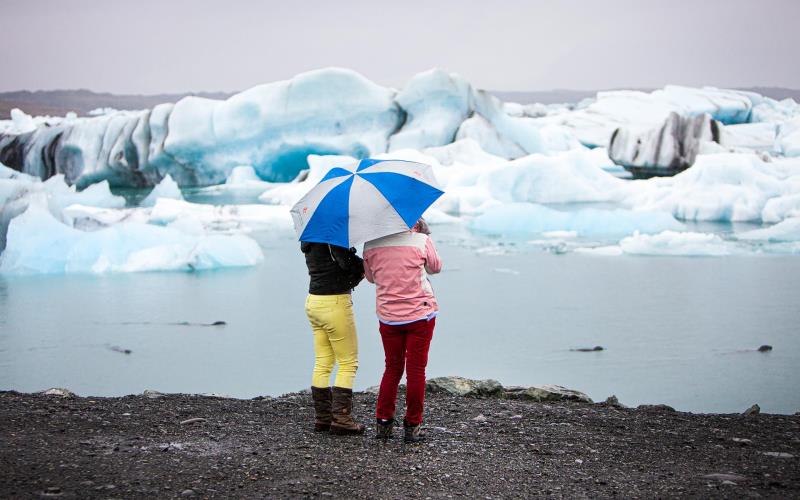Introduction to Iceland’s Climate
Iceland’s auroras and glacial landscapes attract travelers worldwide. Its weather can change quickly, so adequate preparation is crucial. Weather conditions can impact access to attractions, so travelers should pay attention to packing and travel plans.
The Four Seasons in Iceland
Iceland weather by month can surprise even the most experienced traveler, with each season bringing its unique beauty and challenges. During winter, the landscape is transformed by snow and ice, and the days are short, with just a few hours of twilight. However, this is the best time to see the majestic Northern Lights. Spring marks the slow return of sunlight and the melting of winter’s snow, while summer brings almost continuous daylight and a flourishing nature. Autumn welcomes cooler days and a colorful display of reds and golds. However, travelers should be aware of the challenges of each season, such as sudden windstorms or rapid temperature drops.
Essential Gear and Clothing for Icelandic Weather
The Icelandic adage, “There’s no such thing as bad weather, only the wrong clothing,” rings especially true. Visitors must come prepared to enjoy and optimally engage with Iceland’s erratic climate. Essential gear starts with thermal undergarments that wick away moisture, keeping you dry and warm. This is followed by insulating layers such as wool or synthetic fleece to retain body heat. Finally, a waterproof and windproof outer shell is non-negotiable, as it will protect from sudden rain or snow. Footwear is equally critical; insulated, waterproof boots with a sturdy grip are advised for navigating city streets and rugged terrains. Accessories like a warm beanie, gloves, and a scarf will add the necessary final touches for comfort.
Weather Phenomena Unique to Iceland
In addition to its stunning landscapes, Iceland is renowned for its distinctive weather phenomena. The Midnight Sun transforms summer nights into a prolonged twilight, granting travelers extended hours to explore the wonders of this subarctic island. In the deep winter, when daylight becomes scarce, the Aurora Borealis, or Northern Lights, streak across the night sky in an ethereal display of color and movement. Both spectacles are breathtaking and exemplary of how Iceland’s weather can create once-in-a-lifetime experiences.
Driving in Iceland: Weather Considerations
For those embarking on a road trip around Iceland’s scenic routes, weather can significantly influence driving conditions. The same landscapes that beckon travelers can become treacherous under a film of ice or shrouded in thick fog. It is crucial to stay informed about travel alerts and safety advice to navigate the roads of any country. You can find such information on resources such as [resource name], which provides updates on road closures and unexpected weather events. Keeping up-to-date with these updates can help ensure a smooth journey without any hindrances.
Outdoor Activities and Weather Safety
Part of Iceland’s allure is its decadent array of outdoor activities, from hiking dormant volcanoes to glacier walking. However, the weather is a crucial player and sometimes an adversary in these pursuits. Preparing for sudden weather changes can mean distinguishing between a memorable adventure and an uncomfortable experience. Visitors should always consult the weather forecasts, seek local knowledge, and equip themselves with gear and supplies that address the unpredictability of Icelandic nature. Safety is paramount, and respecting the weather’s power ensures you enjoy the grandeur without risking your well-being.
Long-Term Weather Trends and Tourism
Iceland’s climate not only shapes its environmental narrative but also influences tourism. Understanding weather trends can benefit travelers looking to dodge the peak tourist season crowd. Late spring and early autumn usually provide the ideal balance of fewer visitors and relatively stable weather conditions. Moreover, those aiming for specific experiences, like whale watching or enjoying the hot springs, should consider the seasonal patterns that may affect these activities. Consulting these long-term trends can enhance travel plans and allow a more personalized and intimate connection with Iceland’s natural wonders.
The Role of Technology in Weather Forecasting
Technology is a crucial ally against Iceland’s erratic climate in today’s digital age. Mobile apps and websites offer travelers real-time data to confidently navigate the country’s vast and varied landscapes. Apps like these provide precise weather updates and forecasts indispensable for day-to-day planning. In an environment where conditions shift rapidly, such technological tools are not luxuries but necessities for anyone traversing Iceland.
Environmental Changes and Iceland’s Weather
The impacts of climate change on Iceland’s environment are evident and extensively studied. Glacial retreat, observable in real-time, raises concerns about rising sea levels and altered ecosystems. These environmental shifts directly affect weather patterns, altering precipitation and temperature norms that Icelanders and tourists alike have come to expect. Engaging with these landscapes through a lens of conservation and sustainability is crucial. Visitors can help protect Iceland’s natural beauty by being informed and making environmentally conscious choices.
Embracing Iceland’s natural beauty means embracing its weather in all its forms. The whirlwind of conditions throughout the year vividly depicts what makes this island nation so magical. From its freezing winters that showcase the dancing Aurora to its mild summers under the watchful glow of the Midnight Sun, every facet of Iceland’s weather plays a role in crafting the unique experiences that await the intrepid traveler. With the proper preparation, respect for the environment, and a spirit of adventure, your Icelandic journey will leave you with memories as memorable as the land.

